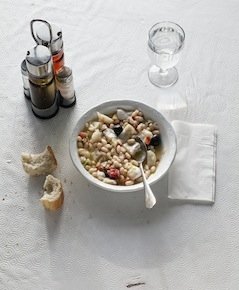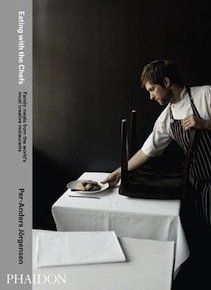Were you to look at the photo at the back, it might appear as a book on monastic cuisine. In the centre, there’s a dish of sausages and beans, next to a bitten piece of bread, an oil jar like the ones we all have at home, a spoon and a napkin. All this is laid on a partly torn paper tablecloth. The dish, in Catalan, is called Botifarra amb mongetes, and in fact it came out of the kitchens of Celler de Can Roca in Girona, until a few weeks ago the first restaurant in the world, according to the World’s 50Best.

Botifarra amb mongetes, Sausages and beans for the employees at Celler de Can Roca (photo credits PAJ/Phaidon)
This is a symbol that finely sums up the effort made by Swedish photographer
Per-Anders Jörgensen and wife
Lotta, who were already the creators of
world-cult magazine Fool. When putting “Eating with the chefs” together, for Phaidon, they visited the backstage of 18 among the greatest restaurants in the world, not to rummage their super-creative recipes, but to observe the way in which all the employees are fed in the most unlikely hours, between one service and the other. This is a pre-cuisine or even meta-cuisine project. The book is built on two levels, even graphic-wise: on one side one is startled by the beautiful photos taking the whole page, composing the backstage report; on the other, we can read the interesting introductions and the 54 recipes (3 per each establishment) of casual dining that anyone could almost always prepare himself at home.
This is a focus on the dishes eaten by, without any distinction, chefs, commis, bus boys, sous-chefs and maîtres, with every hierarchy nullified by the levelling power of the family meal. It is an interesting point of view for the reader, who is curious to test if for the patron the re-adapted Biblical rule applies: «Do not prepare to your staff what you wouldn’t like to have prepared for you». Funnily, out of the 18 restaurants, only one chef makes no difference between the food the staff eats, and the food prepared for the clients:
St John in Smithfield, London, which grills ox hearts with Béarnaise sauce both for the staff and the clients.

The book cover (316 pages, 412 illustrations, 49,95 GBP), you can buy it online
As for the rest, it’s a world that needs to be entirely explored and tasted, from
Noma’s
Brownies to
Chateaubriand’s
Fisherman’s soup in Paris, from
Taiwanese pork belly at
Wd~50 to
Pierre Gagnaire’s
Pommes Alexia, from
Roberta’s Bagels to
Mugaritz’
Paella. The Italian establishments are 2 out of 18, quite a result:
Paolo Lopriore’s
Canto (but he now cooks at
Kitchen in Como, just like
Dan Hunter is no longer at the
Royal Mail but at
Brae in Birregurra, also in Australia) and
Massimo Bottura’s
Francescana. «I chose the first», the author explains
via twitter, «because he is one of the most undervalued chefs in the world, the second because I’ve known him for 15 years: I’m very close to the entire staff and I know every inch of the
Osteria». But also because the photographer and the number 3 chef in the world are united by a common love for football team Inter:
P-A is such a fanatic one would think he was born around San Siro, and not in Ystad, in Southern Sweden, and in fact he straight away describes the black-and-blue posters that the chef from Modena keeps in the kitchen.
It turns out that Lopriore is one of the few in this bunch who wants to cook himself for the staff: «It’s to demonstrate my gratitude». While Bottura’s guys, when they’re not preparing tortellini on an outdoor trip to Lidia Cristoni, enjoy themselves with pizzas, mixed boiled meat, rabbit cacciatora but also yakitori prepared by the important Japanese wing in the team.

Per-Anders and Lotta Jörgensen: "Should we ever work at a second volume, we will go to the far east, the far west and beyond"
The funniest thing, however, happens in New York, in
Wylie Dufresne’s den. This chef is very democratic when he has to choose the music to play in the background while the food for the staff is being prepared: «From the jangly
mariachi music beloved by the Mexicans to the Portuguese
bossa nova that some of the girls bring in, everything is fine. The only thing I forbid in my kitchen is whistling. Whistling is the kind of thing you do when you’re only half working. It is unacceptable».